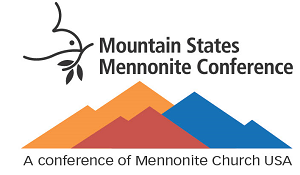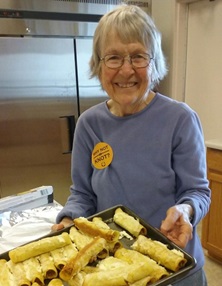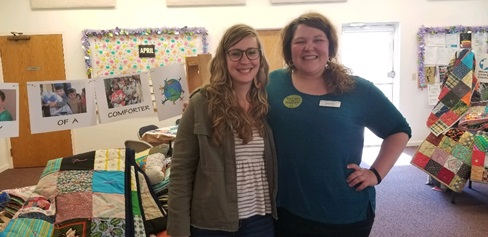By Rhonda Wray
On April 6, approximately 50 women gathered at Casa del Sol’s Aspen Center for a 10:00 brunch featuring speaker Kate Mast, who outlined all the steps comforters go through, from initial creation to final destination.
Guests were greeted with stickers that read, “Why Not Knot?” Following a delicious meal organized by Irene Rhodes, who made over 100 crepes for the event, Bonnie Rufenacht shared how the women in the Arkansas Valley discovered a newfound zeal for comforter-making. “We share and laugh and wonder, ‘Who will get this comforter we’re working on?’” This group of 4-8 women completes three comforters per week. Twila Hannegan from East Holbrook sews all the tops and binds the edges.
Kate Mast, Workroom Supervisor for MCC in Newton, KS, gave an effective and engaging PowerPoint presentation. She shared that comforters are one of MCC’s most needed items. The goal this year is 55,000 comforters! MCC has partners in seven countries who request comforters: Burkina Faso, North Korea, Iraq, Ukraine, Jordan, Burma, and Syria.
Comforter stages include cutting, designing, pinning, piecing (sewing), ironing, adding batting and backing, tying, binding, quality checking, folding, stacking 25 comforters per cart, baling and wrapping each set of 25 in plastic, baled comforters stacked on pallets and loaded on an MCC truck and driven to an MCC warehouse in Ephrata, PA, the warehouse filling requests from the partner countries, comforters transported to the port in Baltimore via train or truck, and then loaded onto a barge for the trip overseas, which can take from three weeks to three months. At the port of entry, the container is opened and checked at customs. Then the comforters are distributed by MCC’s partners. Many go to refugee camps.
“You can just tell when a comforter is made with love, can’t you?” Kate observed. She related that MCC comforters have a reputation for being beautiful, bright, and defect-free. Some recipients even call the comforters “Mennonites”! Comforters are sometimes used in non-traditional ways, such as to keep cold air out around a window, or as a mattress.
The donated fabrics MCC receives must be checked for cultural acceptability. Any material with pigs on it would not be acceptable in predominately Muslim countries, for example. One volunteer joked about using all the unused “pig fabric” to make a comforter for an American MCC sale, calling it “Pigs in a Blanket”!
After a question-and-answer session and time to browse the colorful comforters decorating the room, each woman took home a mini comforter coaster and a head full of knowledge about the difference donated fabric, sewing skills, and love can make—and Kate loaded her car with comforters from the Arkansas Valley that will continue on their journey to their eventual grateful recipients.
ZING! May 2019


